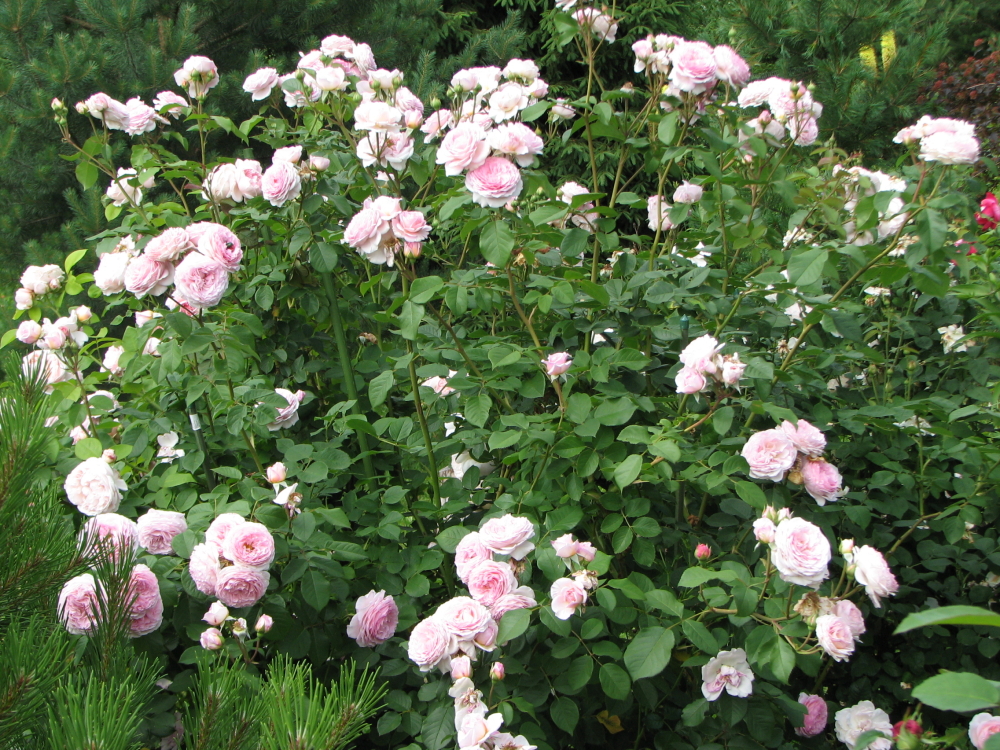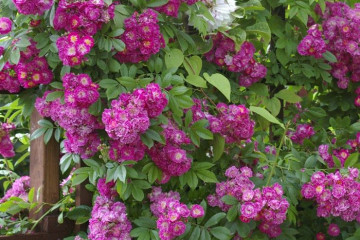Rose James Galway (James Galway) - description of the climber variety
Content:
Florists know dozens of varieties of roses. Everyone has their own favorite. Preference is given to color, shape, smell. But one flower - the rose James Galway - conquered everyone without exception.
Rose James Galway - what is this variety
The English farmer D. Austin struggled all his life with one task - he dreamed of reviving an old British variety of roses with a unique flower shape and an unusual aroma. He got a spherical flower, the petals of which are tightly packed in the form of a pompom. The variety had drawbacks - it bloomed once a season and was often sick.
D. Austin set out to improve the rose. He crossed hybrid tea species, old varieties and floribunda roses. The result of his labors in 1983 was a magnificent flower of the Claymber variety, which began to bear the name of the famous British flutist D. Galway.
Short description
The bush is large, stable with long, drooping stems. A distinctive feature is the almost complete absence of thorns.
The buds are tight, bloom into flowers of an ideal shape. The outer petals are gracefully bent outward. The core is pale pink, fades at the edges.
The scent of Britain's historic roses defies description. It is a long-lasting pleasant scent.
Advantages and disadvantages
The view is distinguished by its undoubted advantages:
- delicate lush flowers;
- unique aroma of rose oil;
- not demanding variety in care;
- cold resistance;
- disease resistance.
The disadvantages include the large size of the bushes, on which the flowers seem insignificant. From excess moisture, black spot appears.
Use in landscape design
The bush, if you do not do deep pruning, grows up to 4 m.This is used by landscape designers. The rose is planted as a backdrop for bright red species.
The plant beautifully wraps around arches and gazebos.
Growing a flower
The plant does not require special knowledge in agricultural technology. All landing manipulations are traditional.
In what form to land
The best option is a seedling. Purchased in specialized stores or nurseries. The plant must be healthy and free from damage.
Pay attention to the root system. Choose a highly developed one without rotten fragments.
What time to land
The rose takes root well in the autumn planting (in September) before the cold weather. In this case, they cover her for the winter.
It is safer to plant park culture in April-May. Long warm days stimulate the growth of the seedling.
Location selection
Choose quiet, light areas in the background of the flower garden. Partial shade is desirable, since direct sunlight burns the leaves.
How to prepare the soil and flower for planting
The culture is unpretentious to soils. The ideal option is slightly acidic soil. Ash and lime are added to reduce the acidity of the soil. When it is necessary to increase, peat is introduced.
Planting procedure step by step
The work is carried out in the following order:
- Dig a hole 50 cm deep.
- Pebbles and sand are laid out at the bottom.
- Humus is poured onto the drainage layer.
- Water abundantly.
- Pour some more earth to make a small mound.
- Place a seedling, spread the roots.
- Sprinkle them with earth. Make sure that the root collar is 5-6 cm deep.
- The soil is tamped and watered.
Plant care
James Galway rose care requires a traditional one.
Watering rules and humidity
The "Englishwoman" loves moisture, but excessive watering leads to diseases. Water when the ground dries up.
Top dressing, soil quality
Feeding schedule:
- June - nitrogen fertilizers;
- the first buds - phosphorus fertilizers and calcium;
- end of summer - potassium.
The earth under the bushes is loosened, weeds are removed, and mulched.
Pruning and replanting
Cutting technique:
- when they want to get a small bush, the shoots are cut in half;
- so that the bushes are large, the shoots are removed by 1/3. This is how a rose-scrub is formed;
- curly roses are cut by 1/5.
Transplant the plant to a new place in the fall.
Wintering features
The culture is winter-hardy, but in the northern regions, the rose is covered for the winter. It is enough to bend the lash to the ground, fix it with staples, and cover it with insulation.
Blooming rose
The James Galway rose blooms in waves: periods of flowering give way to calm.
In the second bloom, all the beauty of the rose is manifested. The flowers become especially fragrant, the color is brighter and richer.
Care during and after flowering
At the time of flowering, the rose is irrigated more abundantly. Watch the buds. Shake off the rain, as English varieties do not tolerate it well.
During the rest period, the plant is treated with pesticides from pests. The soil is loosened.
What to do if the rose does not bloom
If the bushes look healthy, but there are no flowers, they are looking for reasons:
- not enough light;
- not enough air;
- incorrect irrigation regime, incorrect pruning;
- the plant has undergone infectious diseases.
Flower propagation
Propagated in the usual ways for roses: cuttings, layering, dividing the bush.
A little more about the ways of breeding roses:
- cuttings. They are cut in autumn and stored in a refrigerator in peat until spring. In the spring, in a jar of water, they put down roots. In April, they are planted in the ground;
- layering. The lashes are laid in the grooves near the bush, sprinkled with earth. The next year, a branch is cut off from the mother bush, transplanted;
- dividing the bush. It is dug up, divided into parts. Each piece with root and stems is planted in a new place.
Diseases and pests
The causes of rose disease are fungi and viruses. Also, the plant becomes a victim of ticks and aphids. Preventive treatment in spring will save the rose garden from any misfortune.
The English variety James Galway is a permanent resident of Russian rose gardens. The flower is unpretentious, leaving is not difficult. Pruning, watering, replanting are the usual agricultural activities. If you are attentive to a flower, it will delight you with its splendor for many years.


















